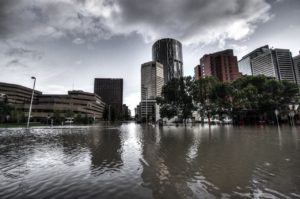The whats, wheres and whys of flood mapping in Canada
0 October 2, 2019 at 11:11 am by Glenn McGillivray
By Ryan L. C. Quan https://commons.wikimedia.org/w/index.php?curid=26873355
After a string of costly and disruptive floods in Canada in recent years, beginning with the $1.5 billion insured loss event in Southern Alberta in June 2013 and the $1 billion insured event in Toronto just a few weeks later, the issue of flood risk and flood maps was brought to the fore in a somewhat jarring manner.
This came as many property owners directly impacted by these and other events demanded to know why they weren’t informed that they live in a flood risk zone, and those unaffected but concerned about future events investigated the potential flood risk presented to their own properties.
As a result of this relatively newfound interest in flood risk and flood maps, ICLR has responded to what appears to be an insatiable demand for information on the topic by publishing ‘Focus on: Flood mapping in Canada’. The booklet is the latest entry in the Institute’s ‘Focus on’ series of bilingual loss control booklets that provide detailed information on specific subject areas. The series was launched in 2015 with Focus on: Sump pump systems. It was followed in 2016 with Focus on: Backwater valves and in late 2018 with Focus on: emergency generators.
The flood mapping booklet was produced in order to provide interested stakeholders with a basic overview of the many issues related to flood maps, including what they are, the various forms they may take, why they are important, and where they can be accessed.
As a direct result of the 2013 flooding in Alberta, property insurers in Canada began to offer overland flood insurance to homeowners in early 2015 for the first time. This change put even more emphasis on the need for flood maps in Canada to be updated regularly and made easily available to those in need of the important information they provide.
However, it would be a mistake to assume that only insurance companies have an interest in up-to-date flood maps that reflect current knowledge and technology. Flood maps are used for a host of reasons and are needed by key decision makers in a number of areas, including land use planning, property development, government disaster assistance and emergency management/first response.
Flood maps may present a variety of different information and may look different in different areas, but one thing all flood maps have in common is that they provide an indication of which areas are at greatest risk of overland flooding related to a defined storm impacting a specific river or coastal area.
One of the challenges associated with floods and flood management in Canada is that there is a fairly large number of government departments and agencies (local, provincial and federal) and other stakeholders that are responsible for, among other things, the issuance of flood maps. This can make gaining access to maps for a given area challenging, as it is often difficult to determine where to go and who to speak to about accessing such maps.
However, for homeowners and other stakeholders interested in learning about the flood risk that is presented to a specific property or area, it is always best to begin by speaking to your local government or agency.
ICLR’s ‘Focus on: Flood mapping in Canada’ can be downloaded in English here. The French version will be posted soon.
Note: By submitting your comments you acknowledge that insBlogs has the right to reproduce, broadcast and publicize those comments or any part thereof in any manner whatsoever. Please note that due to the volume of e-mails we receive, not all comments will be published and those that are published will not be edited. However, all will be carefully read, considered and appreciated.

Leave a Reply